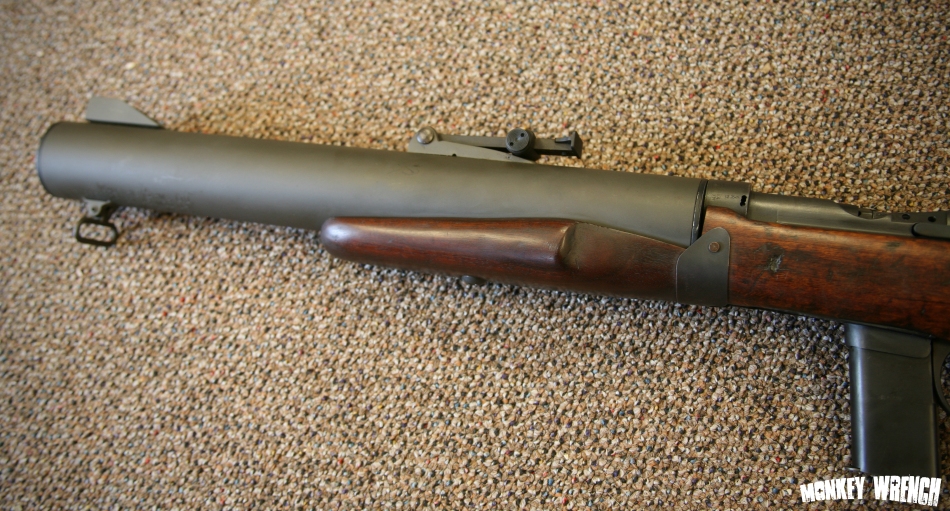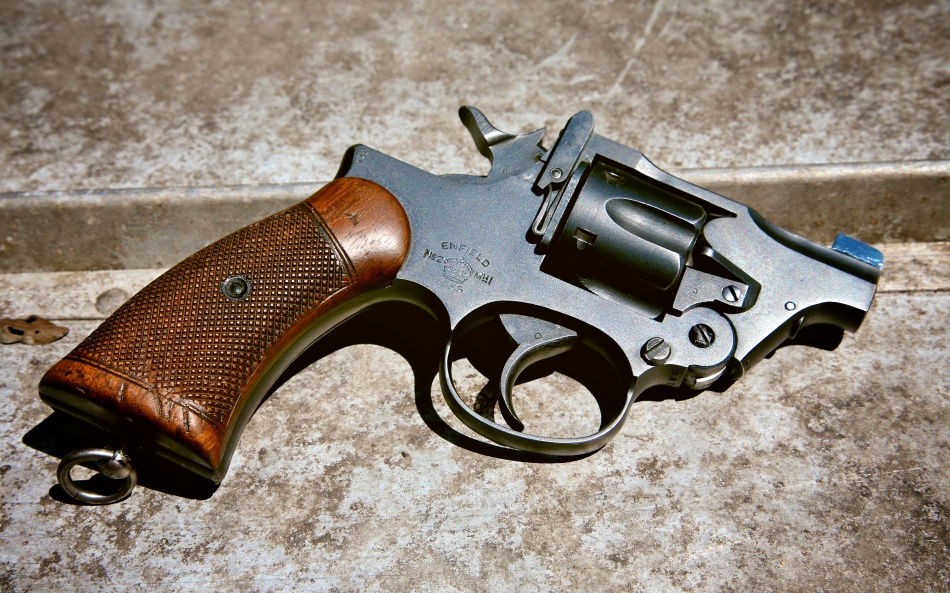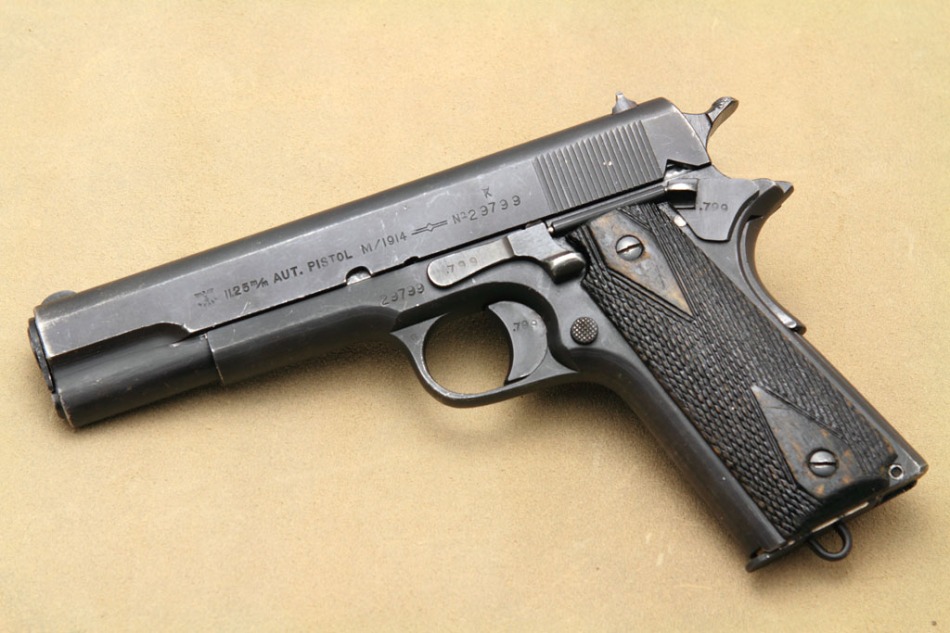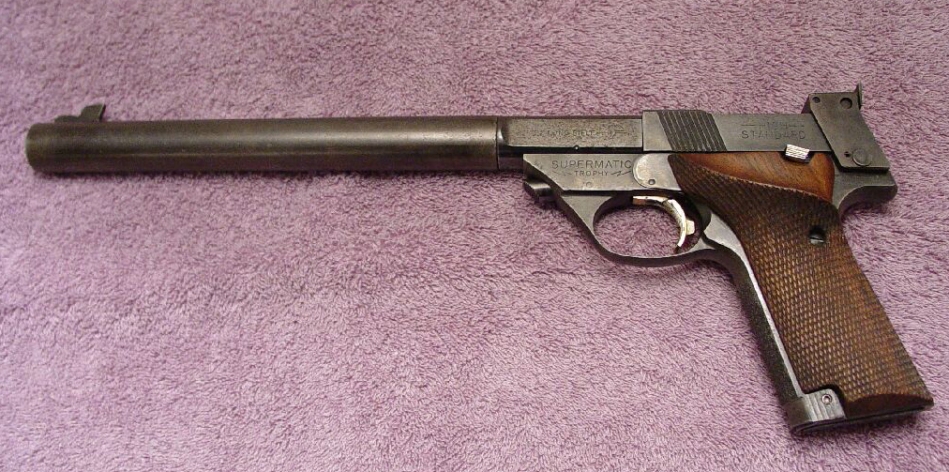A 1911 you don’t see every day.
My friend Todd was kind enough to let me take some pictures of his Remington Rand. The gun has been in his family for quite some time, and unfortunately for me – he doesn’t want to part with it…
HK21 – A work of art.
One of my holy grails in belt-fed guns is the HK21.
A good friend of mine has acquired one of these beauties recently, and while the sear pack is in the process of going from dealer to dealer, the rifle itself was transferred with a semi trigger pack as a Title I firearm.
Fortunately, it resides in my safe for a while until the owner comes around to claim it.
I took the opportunity to take a closer look at it. Whilst not 100% familiar with the differences in 21 models, I know that this is a non-E model, as it has the slide-out feed tray vs. the swing-down version of the 21E.
The rifle is clearly based on the G3 receiver, with hefty reinforcements in place to keep things together. Functionally the 21 is very similar to the G3, rounds come in below the bolt and strip forwards through the link into the chamber. Technically it’s possible to get a magazine adapter and have it run from a normal HK magazine.
Having shot one on a few occasions, I can truly say it’s an impressive piece of machinery, simple yet cleverly designed, usually to be expected from Germans…
The rifle is chambered in 7.62×51, which in full auto makes you appreciate the 18 Lbs of the gun, although it still makes you very aware of what you’re doing.

Inverted belt allow the rounds to be stripped out from the bolt riding above in the forward cycle.

Quick change barrel control. Unlatch, rotate up, and the barrel is free.
Stay posted for a future range report!
A guy walks into a pawn shop….
And walks out with what he believes to be a snub nose .38, for personal and home defense.
What he comes home with, however, isn’t quite what he thought it was.
Not only is it not .38 Special, but it’s in a much shorter, and hard to find caliber: .38 Smith & Wesson.
Perhaps not what he was looking for after all!
What we’ve got here, is a 1935 Enfield No.2 Mk.1, with a barrel cut down to 2″.
Some history on the Enfield revolver.
The No.2 Mk.1 was adopted by the United Kingdom and British Commonwealth in 1931, with an external hammer, fired from both Single Action and Double Action. (SA/DA).
In 1938, supposedly by the request of tank crews who kept getting the hammer snagged onto things in their confined battle stations, the No.2Mk1* was introduced, with a Dual Action Only trigger, and a spurless hammer. In War time, most Mk.1 models were converted into Mk.1*, refitted with a different hammer and trigger mechanism.
At some point or another, a snub nose model was fabricated, based on the No.2 Mk.1*. The barrel was cut to 2″, and the top of the remaining barrel was machined down, and the sight base and blade from the original model were soldered on. The modification almost unnoticeable by the untrained eye, the revolver seemed as if it was made that way. Supposedly a handful of revolvers were modified, and the project was stopped. Few of these snub nose models remain in the UK.
The gun we have here, was a relatively common sight in the ’60s in the US, Enfield revolvers were imported by the bunch and sold by mail order companies by the dozen, and were cheap. To boost sales, few resellers cut down the fine No.2 Mk1* models and soldered a blade on the end for a sight.
The interesting thing seems that the modified ones offered at the time were all Mk.1* models, and not Mk.1 models like this one. Whoever did the modification butchered up a fine revolver, but at least spent some time fabricating and installing the sight. In the right light and clearly visible in the pictures, the difference in bluing is noticeable, and some traces of solder can be seen.
Nonetheless, a nice piece of work.
Is it rare? Not really. Is it valuable? Not really. One thing is for sure though; It’s a neat old thing!
A rare beauty.
At the last Hernando Machine-gun shoot I came across this beautiful Argentina model 1895 Maxim.
In 1895 the Argentinean government placed an order for 50 Maxim guns with Maxim Nordenfelt Guns and Ammunition Company Limited in England. The guns carried serial numbers 1-50.
When the need for more guns arose, another order for 150 more guns was placed in 1898, but thsi time with the Deutsche Waffen und Munitionsfabriken (DWM), licensed Maxim manufacturers at the time.
Numbered 51-200, all the guns were chambered in Belgium Mauser 7.65×53. With the exception of numbers 181-200, all the Maxims built for the Argentinian contract had brass water jackets.
In 1909, Argentina adopted the new 7.65x53mm Spitzer round with the pointed bullet and flatter trajectory. All of Argentina’s Maxims were then re-barreled for the new cartridge and the long sight bar was shortened for the high-speed, flatter trajectory of the new cartridge.
In the 1950s, the guns had become obsolete, and 91 units were sold and exported to the US. The rest of the guns remained in Argentina, in museums, officers mess’ etc. Of the 91 sol to the US, 8 were re-exported, 18 were government owned and ended up in museums, storage and some were destroyed. The remaining 55 US guns ended up in private collections.
The gun I photographed carries number 143, and was part of the second DWM order in 1898.
Cooling down during a cease-fire. The gun is set in its original Ackland tripod, made in England by VSM (Vickers, Sons & Maxim)
The wooden feed roller in the brass feed housing.
(Source: Small Arms Defense Journal for data.)
Jericho 941 Pistol.
In 1990, Israeli Military Industries introduced the Jericho 941. A design based on the very succesful CZ75, the pistols were assembled with components from the Italian contractor Tanfolio.
The gun pictured here is the 9mm Sub-Compact model, using a shorter barrel in the full size frame.
It was imported before 2008 by Magnum Research as the “Baby Eagle Pistol”
I carry this gun loaded with Hornady TAP 147 grain.
The weight of the pistol when loaded is around 2.6 Lbs, taming recoil and making it easy to shoot. The grip angle and the palm swell in the back strap make for an overall very comfortable grip. The Hogue Wrap-around adds to that. The polygonal rifling in the barrel lengthens barrel life, and some say adds accuracy. I find the gun to be very accurate.
Although the pistol looks very similar to the CZ75, it has a few differences. For one, the full size model is considerably heavier, it weighs 2.4 Lbs, compared to the 1.7 Lbs of the CZ75. Another major difference is the decocker/safety in the 941, compared to the CZ, which has a separate decocker.
Sten MkII.
First time out with the Sten MkII.
A Nazi 1911….
Around the same time that the US was choosing a new semi-auto pistol, the Kingdom of Norway was also looking to standardize on a new pistol. They actually ended up selecting Colt’s 1903 Model. However, before they could go into full production of the 1903, the US selected the 1911, which caused Norway to reconsider.
Norway ended up selecting the 1911 with a minor change in the design of the slide stop lever. This was designated as the Norwegian Model of 1914, also known as the Kongsberg Colt (as it was made under license in the Kongsberg factory in Norway).
At the start of WW2, Germany invaded and occupied Norway. Production of the Kongsberg Colt continued while under Nazi occupation. It was designated as the Pistole 657(n). Approximately 8000 were made during the period 1940-1945.
However, only in the last year of production did the Germans add the Waffenamt stamp indicating it was a german weapon. This is one of approximately 920 pistols to receive the German Waffenamt, marking it as a Nazi 1911. Notice the Norwegian modified slide stop lever. Makes it easier to operate with one hand.
As posted by member “Beetle” on Calguns.net, who owns this beautiful and very rare peace of history.
More of the K98-45 Mauser.
I was able to take the gun out today, and shoot it without other shooters around. She functioned flawlessly, the cheap gunshow magazine marked “COLT 45” works even better than the Chip McCormick one. I had ZERO feeding issues today.

I soldered on a rear sight sleeve, and a front sight. The finish I ended up applying was Brownell’s Park-grey. I had two out-of the box failures with the pricey gun-kote they sell. Truly a crappy product.
Next week I hope to properly sight it in.
The original Snub-Nose?
I came across these interesting pictures today, of what appears to be a 44 CAL Confederate copy of a 1851 Colt Navy.
I don’t know the origins of the pictures, or the history of the gun, but I can only imagine what the intended purpose of the modified gun was. Reloading it didn’t seem too much of a concern, as the ramrod assembly was completely removed.
45ACP Mauser video
Finally got the barrel threaded, and was able to test it. AAC Ti-Rant 45 is mounted!
Zombie Slayer SBR Mauser
I received an email this morning, from viper5243, about his SBR 8mm Mauser, I’ve featured on here before.
He informed that he’s had his Mauser refinished, turning it into a Zombie Killer rifle.
The rifle looks great, the addition of the DeGroat Flash Enhancer and the Trench Magazine really make it a one-of-a-kind. Like it wasn’t one already…
The excellent work appears to be performed by 7.62 Precision Custom Firearm Finishes. More pictures can be seen on their site as well.
Model of 1911 US Navy
The gun’s serial number tells us that it was built by Colt in 1918, part of a batch made for the US Navy.
It appears to be in original condition, and as one can expect from a firearm this old, the finish is quite worn. The barrel has a surprising amount of rifling left.
If this gun could tell its story….
Interesting Firearms: DeLisle Silent Carbine
I got to handle and photograph a DeLisle Silent Carbine today. Unfortunately not the original, but the next best thing: A Valkyrie Arms replica.
A brief history of the DeLisle Silent Carbine.
In 1943, Mr William Godfrey DeLisle submitted his .45 ACP DeLisle Carbine prototype to Sir Malcolm Campbell of the Combined Operations HQ for unofficial testing. The testing was done at the Atlantic Seashore, and the gun was noted to have no muzzleflash, even at low light and was “inaudible” at 50 yards. Grouping of 2″ at 50 yards was reported.
DeLisle was ordered to produce an additional small number of carbines, and with the assistance of a few machinists, out of rejected SMLE rifles and Thompson Submachinegun barrels, 17 additional carbines were produced.
These 17 guns were directly put into the hands of British Commando units.
On January 12th of 1944, Mr DeLisle was informed that the “trials to date had been promising”, and by August of 1944, Sterling Engineering Company started production of the carbine, with few exterior modifications. About 130 units were made by Sterling, of which 106 being delivered to Combined Operations.
In the meantime, the 17 prototypes had been used extensively in France by British Commandos, on hit and run missions, all while the ordnance board was still reviewing the design and testing.
The gun pictured is a Valkyrie Arms replica. Valkyrie built the gun true to the original blue-prints, including the design of the suppressor.

Large Volume Suppressor. The Design of the suppressor was a basic Maxim design, consisting of 2 expansion chambers and a simple yet effective spiral diffusion system.

The bore is off-center, to minimize disturbance of the gasses, making the suppressor more effective.
The Valkryie Arms replica is a beautifully built rifle, and not often encountered. Definitely a rare and desirable piece, even for a replica!
I hope to be able to shoot the rifle at my next visit.
Nazi marked Belgian Browning Hi-Power
The FN P35 “Hi-Power” had been in production since 1935. Designed by John Moses Browning, and completed by Dieudonne Saive, the pistol was chambered in 9mm and had a 13 round capacity, and was a desirable military firearm. For comparison, the German issued P.08 Luger and P.38 held 8 rounds of 9mm each. When the German forces invaded and occupied Belgium in 1940, they also took over the FN (Fabrique Nationale, in Herstal Belgium) plant.
The Hi-Power was immediately liked by the Germans, and reassigned the designation Pistole 640(b)
The pre-war inventories of parts at the FN were used to produce more of the Pistole 640(b), all bearing Nazi Waffenamts and the typical swastika-eagle stamps.
When in early ’42 the pre-war inventories ran out, the German led war-production was started up, and most Hi-Powers after that had wooden grips, unlike the synthetic grips used on prior production guns.
My friend Jason owns one of these war-production Hi-Powers. His pistol has a WaA140 waffenamt in it, which indicates it was produced in Belgium between 1942 and 1944 and inspected by the Wehrmacht inspectors in Luttich, Belgium.
His grandfather brought the pistol with him when he returned home from fighting WWII, along with a holster and loaded magazine.
Jason was kind enough to let me photograph this interesting pistol. Unfortunately I forgot to photograph the headstamps on the ammunition it came with. Perhaps another time.
Hi-Standard OSS Pistol.
The illustrious .22 suppressed Hi-Standard HD, has seen use since the OSS days of WWII. These guns are usually based on the older models A, B, D and E.
Less common, is to see a suppressed model based on the model 107 Military.
I came across the pictures below on Falfiles a while ago. The poster made no claim to the weapon, and didn’t know anything about it.
The serial number range dates the gun to be a built between 1968 and 1972. Is it still considered an OSS gun? OSS turned into the CIA in 1947…
From the looks of it, it has seen some use. Perhaps in S.E. Asia?
World’s first modern tank.
During our honeymoon in Paris recently, Mr. and Mrs. Monkey-Wrench came across this neat old tank at the “Musée de l’Armée”
It’s a Renault FT17 from 1917, and saw action during “The Great War”.
It was called the first modern tank, because it was the very first tank to feature a fully revolving cannon, a driver in the front and the engine in the back. Most modern day tanks still have these features.
Bullpup FAL
I came across the following image:
A very crudely made FAL Bullpup conversion. Made mostly with commonly found hardware and spare FAL parts, like the front and rear sight bases.
Interestingly enough, they left the original front and rear sights in place.
The cheek-weld looks like a piece of rubber, riveted to the top cover. I wonder what the ejection pattern looks like.
I’m not sure if this is a home-built special, or if it is some kind of prototype, but the file-name lead me to believe it’s Venezuelan.
Elisco Tool Company M16
In 1983, Armalite was sold to the Philippine “Elisco Tool Company”. All of Armalite’s Costa Mesa AR-18 tooling went to the Philippines, and Elisco also manufactured M16s.
My friend “Zack3g” spotted this Elisco M16 on a recent trip to the Phillipines. I believe it was carried by a hotel guard.
Do-It-Yourself weapons of the Libyan Rebels
Ingenuity and improvising at it’s finest!
Interesting firearms: Springfield Armory Full Railed Operator
Today, we’re taking a closer look at a bit of an unusual pistol, the Full Rail Operator, by Springfield Armory.
Love them or hate them, they are impressive pistols. The giant rail, and un-cut slide gives it a tough and heavy look. While the gun is a bit heavier than a normal one, it is not as nose heavy as a Bull Barreled gun is. What is the rail for? Mount lights. Maybe in combination with a laser, but that’s about it. Adding a foregrip would look weird, and would not only be useless, but would also be a violation of the 1934 NFA, as a pistol can not have a vertical front grip.



































